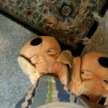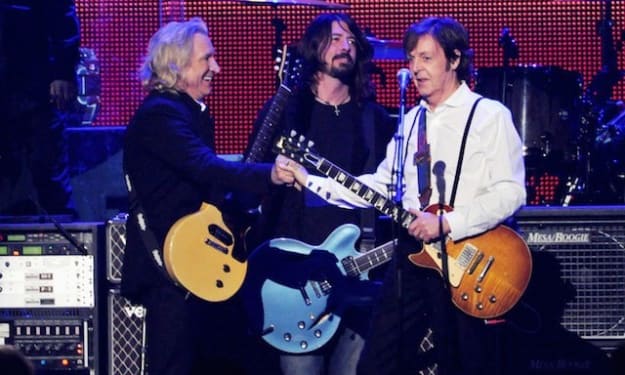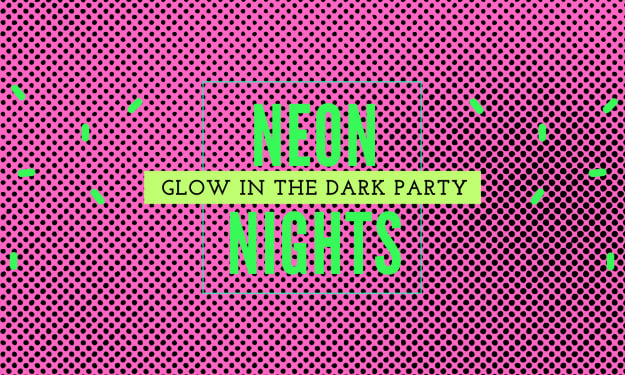
We’ve seen it time and time again. Bands breaking-up and getting back together again somewhere down the line.
Why do most bands break-up? It’s usually either down to creative or personal differences and on occasion it’s a mutual decision to part ways on good terms.
So, when they reunite you could chalk it down to either the money, a reconciliation between the members or something that was already in the works from when the band first broke up.
However, there have been times where some bands found themselves back together through circumstances none of its members could ever possibly envision. In this list, we will cover 5 of the most unique circumstances that led to the reunion of some iconic bands.
A Desire To Help Others: The Doobie Brothers

We have seen our share of bands reuniting for a charitable cause. The most iconic to come to mind would be Pink Floyd in 2005 for Live 8 and Led Zeppelin in 1985 for Live Aid (more on that later). However, you will soon see why the Doobie Brothers reunion in 1987 stands out a little more.
By 1987, The Doobies had been broken up for around five years. Owing to the band’s drastic musical change from their heavier rock sound under Tom Johnston to a more r&b, pop oriented approach under Michael McDonald, many of the band’s original members had gradually left the group.
By 1982, only one original member, Pat Simmons remained and when he called it quits, the decision was made to dissolve the band at the close of their farewell tour. Going out in style and ceremony, it seemed that each of the Doobies had moved on from that chapter in their lives.
However, drummer Keith Knudsen who had played in both incarnations of The Doobie Brothers was on a personal mission. Having recently overcome his drug addiction, Knudsen was on a quest to help others. Deciding to focus his efforts on raising money for the Vietnam Veterans Aid Foundation, Knudsen sought to reunite the Doobies for a one night fundraiser concert.
What stood out about this reunion was the fact that it did not bring together a particular line-up of the band. Instead, Knudsen was able to convince 11 other Doobie Brothers to join him. This was all but 2 people who had been members of the band up to that point. With 5 members who could sing lead, 4 who could play lead guitar, 4 drummers, 2 keyboardists, 2 percussionists and a sole bass player, the concert attracted fans of every line-up of the Doobies that had been in existence.
With a sell-out show that featured a stacked line-up that could play songs from throughout the band’s entire history, the one night concert soon evolved into a 12 date tour. Soon enough, that tour became a permanent reunion for the group in 1989.
Although their full time line-up was more reminiscent of their original incarnation, the Doobies continued to collaborate on and off with other former members from time to time. Knudsen rejoined The Doobies full-time in 1993 and remained with them until his death in 2005. The Doobies continue to perform full time to this day.
Had it not been for a single man’s desire to do good, we may not have seen such a successful reunion. It goes to show that a genuine cause can bring all manner of people together and it should serve as an example that doing good for others can only serve to do you good too.
A Departed Friend’s Legacy Led Zeppelin

Few bands can ever reach the heights Led Zeppelin climbed. Often recognised as the band that innovated the hard rock and heavy metal genre, Led Zeppelin was an elite group both live and in the studio.
With the powerful vocals of Robert Plant, the masterful guitar playing of Jimmy Page, the skills of John Paul Jones on bass and keyboards and the unmistakable drumming of John Bonham, no group could come close to the musical epics released by Led Zeppelin.
When Bonham died in 1980, the group was never quite the same and they knew it. It was because of that, the decision was made to dissolve Led Zeppelin. Following their break-up, Plant and Page would continue to work together to varying degrees of success while Jones chose to shed his rockstar image for a successful career as a session musician and producer.
In the years following their break-up, the three remaining members of Led Zeppelin would occasionally reform the group for brief performances such as 1985’s Live Aid. These performances were admittedly disappointing with the members not being shy to admit how poorly each one of these short sets went. The chemistry they had as a four piece group could not be replicated with other drummers and at the same time, their personal relationships with each other began to deteriorate.
However, despite the growing tension between the three remaining members of Led Zeppelin, they would still reform for the odd performance from time to time thanks in no small part to one person. That person was Jason Boham, the group’s new drummer and the son of original drummer, John Bonham.
Taught the drums from an early age by his father, Jason was a seasoned drummer who had been playing his father’s iconic beats from the time he could pick up a drum stick. In addition to his skill and familiarity with the music of Led Zeppelin, Jason was also personally acquainted with his father’s bandmates, having known them all his life and working under them.
Jason’s presence served to reignite the chemistry of the band and perhaps out of respect for their fallen friend, Page, Plant and Jones always seemed to step up their game and put their squabbles aside every time Jason sat behind those drums. Every time Led Zeppelin performed with him, Jason was well received by fans and critics alike.
Whether it be another one off appearance or a more extended reunion project, you’d best believe that if the day comes for Led Zeppelin to reunite again, Jason Bonham will be there behind the drums once more. Until then, the band’s legacy continues with Bonham’s Led Zeppelin Evening tribute group.
A Reward For A Promise Kept: Crosby, Stills, Nash (and Young)

In my earlier article about Supergroups, I briefly mentioned CSN(Y) as a shining example of a successful Supergroup. With beautiful harmonies, talented musicianship and socially relevant songs, CSNY will forever remain in the hearts and minds of generations of listeners.
However, unlike their signature harmonies, the relationship between the 4 men was anything but harmonious. Sometimes as close as brothers and at other times the most bitter of enemies, creative differences and the individual eccentricities of each of them contributed to the constant tension among the group. This was further exacerbated by copious amounts of drugs and alcohol.
By 1985, CSNY had broken up, reformed and then broken up again. Although CSN in itself was a successful trio, the excesses of the rock and roll lifestyle began to take its toll on David Crosby. By the 80s most musicians of that era had begun to clean up their lives. Crosby however, was continuing on a downward spiral.
With his drug use affecting him both on and off stage and showing no signs of slowing down, Neil Young (arguably the group’s most famous member) made his former bandmates a promise. Despite having left the group on rather acrimonious terms a few years earlier, Young promised that he would return and reform CSNY once Crosby had sorted his life out.
It took Crosby 2 more years to beat his demons. During that period, Crosby served 9 months in a Texas prison for various drug and weapons offenses. Many, including Crosby himself have felt that his prison sentence was the push he needed to get his life back on track. Shortly after his release from prison, Young kept to his word and rejoined his former band.
CSNY released the album American Dream in 1988 and although it was far from the group’s best work, fans and critics alike were happy to see David Crosby happy and healthy again. Despite the underwhelming album, CSN was back in full swing as a trio thanks to the promise Neil Young made to put the group back together.
Although they primarily remained a trio for most of their time spent back together, Young would collaborate with his former bandmates more frequently and perform with them as CSNY on numerous occasions. Off-stage, the relationship between the four had also grown far more stable until a rift between Young and Crosby in 2015 inflamed tensions once again.
Despite the renewed hostility between CSNY, one thing that cannot be undone is the promise that Young had made to Crosby in the 80s. While a prison sentence may have caused Crosby to get on the straight and narrow, the reformation of the iconic group could very well have been what kept him on the up and up for the past 3 decades.
It goes to show the full circle journey being in a band could take a person in. Crosby’s lifestyle was a result of his being in the music business. That same lifestyle eventually forced him out of said business and the prospect of returning to it once more was what made him change his lifestyle. In many ways, it’s quite a journey in itself.
Presidential Persuasion: Fleetwood Mac

Sticking to the topic of groups with contentious relationships among its members, we have the group that turned it’s dysfunction into its strongest asset, at least for a time. Fleetwood Mac had it all. Creative differences, scandalous affairs with one another, divorce and power struggles all of which were fuelled further by drugs and alcohol.
However, instead of letting these issues destroy the group, Fleetwood Mac were able to channel these raw emotions into the musical masterpiece, Rumours. Unfortunately, the success of the album did not do anything to ease the palpable tensions among the members. Following Lindsey Buckingham’s departure in 1987, Fleetwood Mac unsuccessfully attempted to go on with an updated line-up. The final nail in the coffin was when Stevie Nicks left the group in 1991 and Fleetwood Mac unceremoniously disbanded, a shell of its former self.
In the years to follow, the members mainly focused on their own endeavors and despite loosely collaborating now and then, Fleetwood Mac was a thing of the past. However, they would soon return to the public eye in a most unexpected way.
Among the candidly scathing songs on the Rumours album, one song in particular stood out. Written by Christine McVie and sung by both her and Lindsey Buckingham, Don’t Stop was well known for its upbeat melody and optimistic lyrics which conveyed a message of putting behind and moving toward a better future.
Perhaps drawn to it’s positive message and memorable chorus, Presidential Candidate Bill Clinton began using the song for his campaign. Through its use as Clinton’s campaign theme, the song once again began making waves and when Clinton won the Presidency, he personally appealed to the Rumours line-up of Fleetwood Mac to perform the song live for his inauguration.
The 5 members agreed to put their shared hostility aside and accept the honor of performing at such a historical event. It was the first time in 6 years that the full Rumours line-up of Fleetwood Mac performed together. Although the members had no intentions of reuniting full-time, they could not deny the renewed public interest in the group brought about by the President’s use of their song.
Over the next few years, Fleetwood Mac quietly reformed under less renowned line-ups while the band’s Rumours line-up began collaborating with each other more often. Eventually, the decision was made to fully reform the band in it’s most iconic formation in 1997.
Since then, Fleetwood Mac had maintained it’s Rumours line-up as faithfully as possible. The only exceptions being when Christine McVie retired from the group for a number of years before returning in 2014 and when Lindsey Buckingham was fired in 2017 and was replaced by Neil Finn and Mike Campbell. However, with a group like Fleetwood Mac we can never rule out the possibility of the group going back to it’s full Rumours line-up one last time.
We will probably never see another situation like this again. An American President causing the reformation of an iconic rock band thanks to a song recorded close to decades prior. Fair enough, we may have seen Fleetwood Mac reunite without Bill Clinton’s intervention but thanks to him, we were able to ensure that when they did reunite, they did so in their best formation.
Attending A Wedding: The Police

Arguably the greatest power trio of all time, The Police had a distinctive sound and an irreplicable musical chemistry. However, at the height of their success in 1986 they decided to break up, much to the shock and disappointment of their fans.
With all 3 of its members being equally talented and without a clear leader in the group, an intensely competitive streak developed amongst Sting, Stewart Copeland and Andy Summers. In trying to outdo one another, both creative and personal tensions began to develop between them and they were eventually forced to break up the band in order to salvage what was left of their relationship.
In the years following The Police’s breakup, the 3 members found success in very distinct areas of music. Sting had gone on to become a successful solo act, Summers returned to his fruitful career as a session musician and Copeland had forged a prolific reputation as a producer of music for movies, tv shows and video games. Along with their individual success, the 3 men had also rekindled their close friendship but were very clear that they would not reform The Police in order to avoid conflict.
However, in 1992 Sting had gotten married to Trudie Styler and had invited his former bandmates to the wedding. At the reception, the guests were quick to point out the fact that all 3 members of The Police were under the same roof and urged them to pick up some instruments and perform for them.
Initially hesitant, Sting, Summers and Copeland soon gave into the pressure and played an impromptu set using the leftover equipment of the wedding performers. Despite the last minute, “low budget” performance, the crowd went wild and the 3 friends realized that they had not missed a beat.
In spite of having not performed together in 6 years and pressured into an impromptu performance, The Police’s chemistry remained perfectly intact. Following this, Sting, Summers and Copeland began collaborating more often and more openly on each other’s solo projects. They also began speaking more on their time together as The Police and no longer ruled out the possibility of future performances.
The 3 men got together again for The Police’s Rock and Roll Hall Of Fame Induction in 2003 and in 2008 embarked on a full fledged reunion tour. Becoming that year’s highest paid artists, The Police showed beyond a shadow of a doubt that they could still handle the rigors of a tour and a full length concert.
While The Police’s 2008 reunion tour was a roaring success, Sting, Summers and Copeland have once again ruled out the possibility of future reunions. Despite that, they continue to remain friends and it seems that they have chosen to prioritize their friendship over the full-time reformation of The Police.
The Police’s breakups and reunions are a good example to show the power of maintaining friendships in the music industry. It was the desire to preserve their friendship that caused them to break-up and pursue their own goals and it was said friendship that eventually brought them back together once more.
Unlike many bands who make the conscious decision to reunite with months and months of planning, the seed to The Police’s eventual reunion was planted simply because Sting, Summers and Copeland just happened to be in the same place at the same time. To me, there isn’t a more interesting circumstance that brought a band back together.
Well, that’s it for this list. If you made it this far I’d just like to say thank you for reading this article and if you know of any other interesting reunions, please let me know. Till then, take care!
About the Creator
Isa Nan
Written accounts of life, death and everything in between






Comments
There are no comments for this story
Be the first to respond and start the conversation.